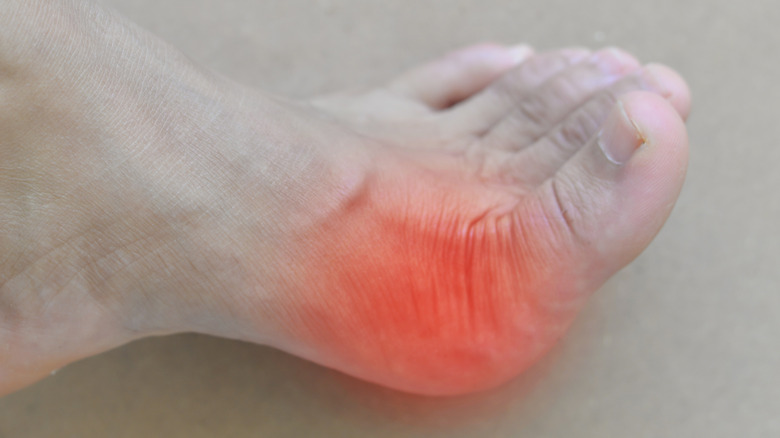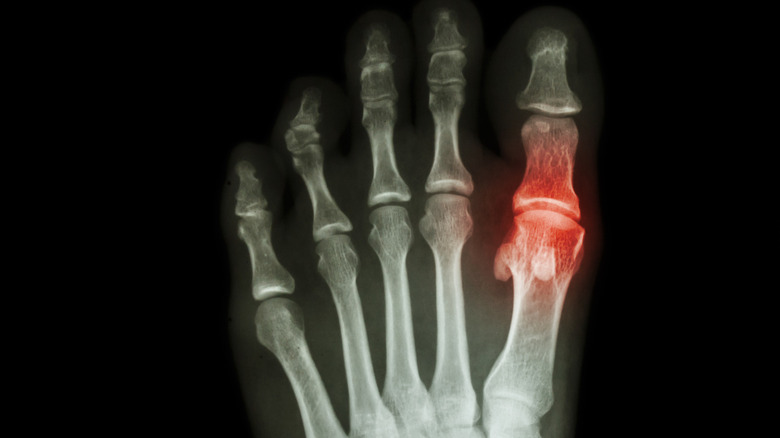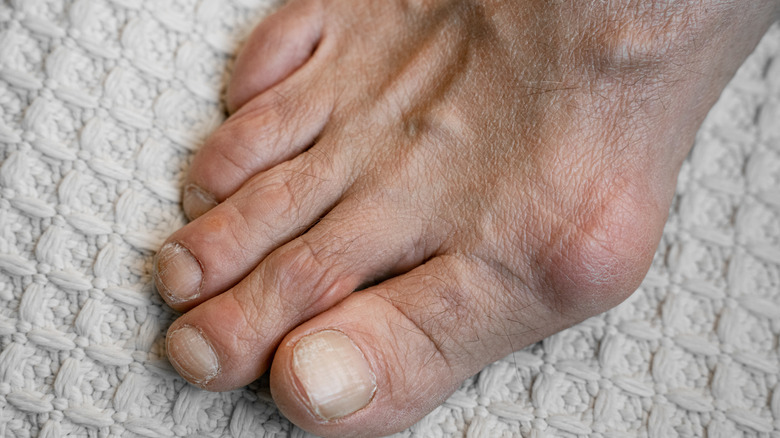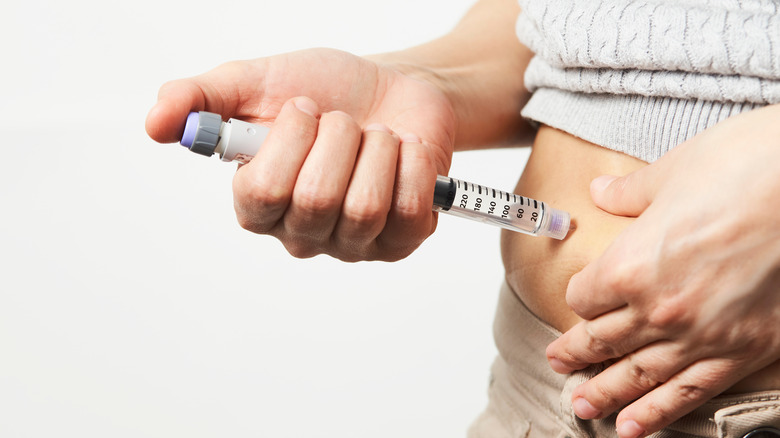Gout Explained: Causes, Symptoms, And Treatments
Gout is one of the oldest diagnoses known to humankind, according to a 2000 paper published in the journal Arthritis Research & Therapy. it's also the most common form of inflammatory arthritis (the kind of arthritis that is not autoimmune in nature), per the Gout Education Society. Considering that gout — or gouty arthritis, as it has sometimes been more formally referred to — was first diagnosed in 2640 BC (per Arthritis Research & Therapy), it's a bit of a paradox that gout also happens to be one of the most misunderstood of all diagnoses (via Healio).
The word "gout" brings to mind such portly aristocrats as Benjamin Franklin and Henry VIII of England, both of whom were diagnosed with gout. That's because for most of the last forty-six hundred years, gout was, in fact, a condition that was associated with the privileged class. (And rightfully so, for reasons we'll delve into as we continue our discussion of gout below.)
Nevertheless, gout has become much more of an equal opportunity affliction in the modern day – and a painful one at that, according to NBA coach and Hall of Fame player Maurice Cheeks, who has dealt with his gout by wearing only one shoe while coaching the Philadelphia 76ers during a flare-up. Join us as we explain gout, including what really causes it, who gets it, how it's diagnosed, and how it's treated.
What exactly is gout?
Gout is a painful inflammation of one or more joints caused by an excess of uric acid in the blood, per the health professionals at DeNiel Foot & Ankle Center (via Instagram). Gout is systemic, even if it presents as the inflammation of only one or two joints at a time. The Greek physician Hippocrates referred to gout as the "unwalkable disease," per a 2000 paper in Arthritis Research & Therapy. But he also called it the "arthritis of the rich," because when it was first identified in ancient Egypt and throughout most of recorded history thus far, gout was diagnosed primarily in people who could afford to eat meat and seafood regularly — perhaps to the exclusion of other food groups — and wash it all down with beer and other spirits and sweet desserts (via News-Medical).
It wasn't until the second century A.D. that the Greek physician Galen woke the medical community up to the notion that gout and its causes are much more complex than previously thought (via Arthritis Research & Therapy). It is now understood that meat, seafood, and beer all contain high levels of purines, a substance which the metabolism breaks down into uric acid for excretion through the urinary system. Diets high in purines can cause elevated levels of uric acid in the body. However, some people are more genetically predisposed to the condition than others. Nowadays, diets high in purines are widely available, making gout an equal opportunity affliction.
What are the symptoms of gout?
According to the Centers for Disease Control and Prevention (CDC), an attack of gout is generally characterized by intense pain in one joint — often the metatarsophalangeal joint (the MTP), which connects the first bone of the big toe to the first metatarsal (via Harvard Health). This pain is almost always accompanied by swelling, redness, and heat, which are all symptoms of inflammation (per Verywell Health). Because the MTP bears the body's body weight and bends with every step the foot takes, it's difficult to ignore.
Nevertheless, when a group of doctors and other researchers from the U.K. interviewed 43 patients with gout (29 men and 14 women, via a 2015 study published in BMJ Open), they found that although many presented with severe joint pain with "no obvious signs of physical trauma," they nevertheless endured a prolonged pre-diagnosis odyssey consisting of numerous medical consultations and examinations and lab testing. In many cases, the patients caused their own delays by resisting the suggestion their pain was caused by gout (hello, incorrect preconceived notions about gout). In some cases, the delay was attributable to pain presenting in a joint other than the MTP, which is where people "expect" gout to occur. In some cases, limitations in the accuracy of blood serum testing for hyperuricemia (excess uric acid levels, which is the definition of gout) raised patient doubts.
A gout diagnosis often begins with pain, but not always
A gout diagnosis will often begin with a patient complaining of intense pain and related inflammatory symptoms in one joint, per Global Healthy Living Foundation's Creaky Joints. However, not all joint pain is arthritis, and not all arthritis is "gout," according to Verywell Health. To determine whether someone's joint pain and related inflammatory symptoms point to gout, clinicians generally start by asking questions, including whether the patient sustained a joint injury that might help rule out gout and if they (or their family) have a history of hyperuricemia or gout.
In addition, a clinician may want to know about one's diet and metabolic health, including any previous diagnoses of diabetes, hypertension, heart disease, or kidney disease. When it comes to women, despite a dearth of famous women known to have gout (via Health), clinicians may want to inquire as to the date of the last menstrual period, as the risk of gout in women increases after menopause (per Creaky Joints).
However, a gout diagnosis may also begin with nothing more than a lab test showing elevated serum uric acid levels. In fact, uric acid levels of more than 6.8 mg/dL, which may or may not be accompanied by joint pain and related symptoms, literally define a gout diagnosis. Nevertheless, "most people with hyperuricemia never develop clinical gout," according to rheumatologist Alireza Meysami.
What tests are involved in diagnosing gout?
When an individual presents with acute joint inflammation, a healthcare professional may (in limited cases) be able to make a differential gout diagnosis without resorting to lab testing, according to Creaky Joints. However, a definitive gout diagnosis requires lab testing, including confirmation of elevated uric acid levels in the blood or urine. Once a gout diagnosis (whether differential or definitive) has been made, more lab testing will be done to determine the extent and stage of the condition.
These may include needle aspiration of joint fluid followed by microscopic analysis for the presence of telltale crystals, which are considered markers of gout. Lab testing may also include x-rays and other imagining to look for visual signs of inflammation in the affected joint, as well as signs of long-term damage to the affected joint as a result of the buildup of gout crystals. There may also be ultrasonography and other imaging to rule out involvement of joints other than those that may be currently symptomatic (per the Mayo Clinic). In addition, other conditions that may involve crystallization in the joint fluid will have to be ruled out.
There are four stages of gout
As noted above, in some cases of gout, hyperuricemia will be observed even where the individual is not experiencing joint pain. This is considered a "stage 1" gout diagnosis. In such cases, the goal is to address and treat the hyperuricemia with the hope that it will never progress to what is known as an "attack" of gout — meaning the presence of intense pain and related inflammatory symptoms.
An actual attack of gout is considered to be "stage 2" gout. If left untreated, a first attack of gout will last anywhere from three to 14 days. The hope, in that case, is that effective treatment and lifestyle changes can prevent subsequent attacks, which are known as "flares" or "flare-ups." Indeed, "some people can go years before another attack," according to rheumatologist Dr. Theodore R. Fields (per Creaky Joints). Nevertheless, Dr. Fields also points out that "it is the nature of gout to have flares and then quiet down for a period of time before the next flare." Again, the goal of treatment is to manage uric acid levels to prevent future flares — and to prevent permanent damage to bones and/or progression to "stage 4."
Stage 4 is when gout crystals from nodules known as "tophi." "Tophaceous gout" is associated with pretty much constant pain. However, "it usually takes many years of uncontrolled [and untreated] gout for someone to get into this stage," Dr. Fields points out.
Gout puts you at risk for permanent bone damage
Untreated gout can lead to permanent bone damage in the effected joints, according to Creaky Joints, and this damage tends to progress even during times when one is not experiencing a gout flare-up. Such damage can include "bone erosion, new bone formation, deposition of tophi within tendons, focal cartilage loss, and eventually complete destruction of the join," according to Musculoskeletal Key.
Of these, bone erosion appears to be among the most common of complications. Bone erosions are, as the name might suggest, areas of significant and debilitating bone loss (per Osteoimmunology), and are associated with other types of arthritis as well, according to the author of a 2007 paper published in the Journal of Arthritis Research & Therapy. A 2018 study in Arthritis Care & Research suggested that nearly 44% of all individuals diagnosed with gout will end up having "bone erosions."
Permanent bone damage is most common with stage 4 gout because the damage tends to be precipitated by the development of tophi (gout-related crystal deposits in affected joints), per Creaky Joints. Other circumstances that increase the risk of permanent bone damage include comorbidities associated with metabolic syndrome such as high blood pressure, high blood sugar, and kidney disease. As noted above, laboratory imaging and other testing can detect the presence of bone damage and its precursors (via Creaky Joints) so that treatment can be initiated or adjusted before more extensive damage is done.
A gout diagnosis puts you at risk for these other conditions too
According to a 2013 academic paper in the journal Rheumatology (Oxford), those who have been diagnosed with gout are also more likely to be diagnosed with obesity, hypertension, cardiovascular disease, diabetes, and elevated triglycerides (i.e. hyperlipidemia), whether individually or in some combination. And vice versa. Moreover, all of these, along with low levels of HDL cholesterol (the "good" kind) and excess fat around the midsection, are among the diagnoses that may come together to form a diagnosis of metabolic syndrome, of which a diagnosis of gout also increases one's risk.
Complicating matters further is the fact that each of these comorbidities is known to increase the risk of developing gout, and that treatment choices may impact the progression of — and treatment choices for — gout. To put it in simpler terms, although gout presents in a joint or joints, it is, in fact, a metabolic condition that puts one at risk for cardiovascular disease. And while gout has a genetic component, lifestyle choices that increase your risk of gout also appear to increase your risk of metabolic syndrome and cardiovascular complications.
Adding insult to injury, the mere presence of excess uric acid in the body can directly damage not only bones and joints, but also the kidneys, pancreas, blood vessels, and other organs. And hyperuricemia has also been associated with depression and sleep apnea. Fortunately, controlling gout makes it easier to treat these comorbidities, and vice versa.
Who is at risk for gout?
While gout is no longer the exclusive province of the leisure class, a diet that's unnecessarily high in protein (especially red meat and shellfish), sugar (especially fructose), and/or spirits (especially beer) can increase anyone's odds of a gout diagnosis. Your genetics may also place you at higher risk, which you may not know until you've already been diagnosed. Accordingly, anyone who has been diagnosed with any of the conditions underpinning metabolic syndrome, and anyone known to be at an elevated risk thereof, is at higher risk for developing gout, per a 2012 paper in Rheumatology (Oxford).
Other conditions associated with hyperuricemia include long-term taking of diuretics (i.e. "water pills"), which can impair kidney function over time, according to MedStar Health. Taking other blood pressure-reducing medication may also increase the risk of gout, although it's possible that it's not the medication but the underlying high blood pressure that is increasing the risk. Other factors that increase gout risk are congestive heart failure and insulin resistance (whether or not in the context of a diabetes diagnosis).
In addition, just being a middle aged man, elderly man, or post-menopausal woman raises your risk of gout (per the CDC). One reason is that estrogen may offer some protection against gout, or at least gout flare-ups. So, one might presume that hormone replacement therapy could lower the associated risk. Unfortunately, that does not appear to be the case, via a 2021 study published in Arthritis, Research & Therapy.
Treating a gout flare-up
When we talk about how gout is treated, it's important to distinguish between treating gout as a systemic, progressive disease versus treating acute flare-ups of gout. One reason is that some of the treatments doctors prescribe for preventing future flare-ups can actually exacerbate an attack once it's in progress, according to rheumatologist Dr. Theodore Fields (via Hospital for Special Surgery). So if you're dealing with your first attack of gout, it's probably not the appropriate time to start preventative therapy. It would be better to focus on managing the attack until it has resolved. When dealing with any acute attack of gout, the most important principle is that the faster you start treating it, the faster you should be able to find relief. Waiting even one day can significantly delay your recovery.
NSAIDs and COX-2 inhibitors are "the mainstay of therapy of acute attacks of gout," Dr. Fields points out. Steroidal anti-inflammatory drugs are also useful in the short term. A drug called colchicine has been used to treat acute attacks, but it's fallen from favor due to unpleasant gastrointestinal side effects and unpleasant interactions with other medications. Apart from drug therapy, it can be helpful when dealing with a gout flare-up to stay off your feet. Again, while exercise can help make attacks happen less often and with less severity, it's best to skip it while in the midst of an attack.
What you can do to avoid gout flare-ups, including your first
If you have already been diagnosed with a mild case of hyperuricemia but have not yet had your first gout flare-up, you may still have some success staving off a flare-up by observing a strict anti-gout diet — one that limits red meat, shellfish, beer and other spirits, and foods that are sugar-sweetened, according to Dr. Fields (via Hospital for Special Surgery). In addition, anything that might contribute to weight loss is considered helpful. That also includes becoming or staying physically active. When combined with a healthier diet, this can reduce the risk of having an acute attack.
However the higher your uric acid levels are, the more likely it becomes that preventing gout attacks will require drug therapy to complement your lifestyle changes. Medications that may be prescribed to prevent acute gout flare-ups include colchicine, which works by reducing the ability of uric acid crystals to cause inflammation. Allopurinol and febuxostat can be taken to decrease uric acid production. Pegloticase can help increase your rate of breaking down uric acid, while probenecid and lesinurad can improve your rate of excreting uric acid.
Alternative gout treatments
Although he's a traditional rheumatologist working at one of the nation's top hospitals specializing in musculoskeletal health, Dr. Fields is nevertheless open to the possibility that various foods and supplements may be able to help diminish the inflammation that elevated blood levels of uric acid may cause (via Hospital for Special Surgery). However, as he points out, "lowering uric acid is the key to success in gout management." That's why Dr. Fields views cherry juice as an alternative remedy with some level of optimism. Cherry juice may help the body to decrease uric acid production. In addition, its vitamin C content may support the kidneys in excreting uric acid more efficiently. However, we're talking marginal effects here, so it may only benefit people with blood levels that are just approaching hyperuricemia.
Curcumin, which is a component in turmeric, holds promise, but it requires further study. What has been established through extensive study is the safety profile of existing drug therapies for gout. "The safety profile of treatments for gout is generally quite good," Dr. Fields notes. "For this reason, I believe that the great majority of gout sufferers would be well-served to explore traditional options for gout first and then choose their options. Many of my patients have explored a variety of non-traditional approaches to gout, often in combination with traditional measures."












